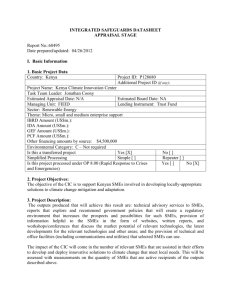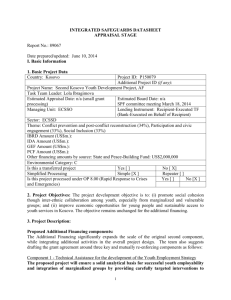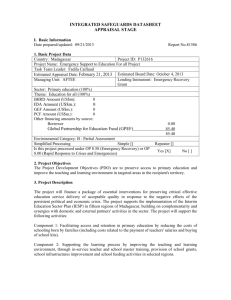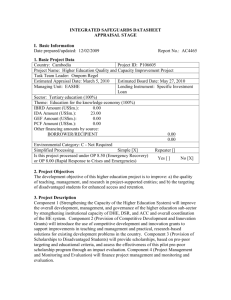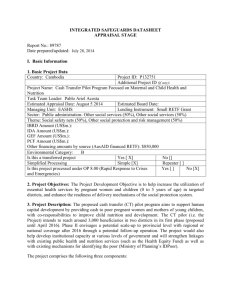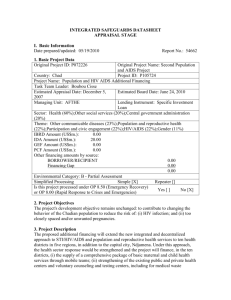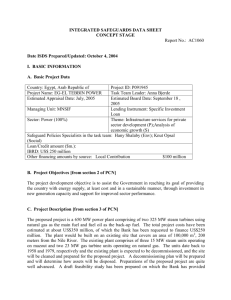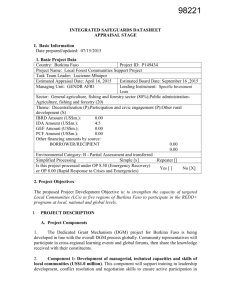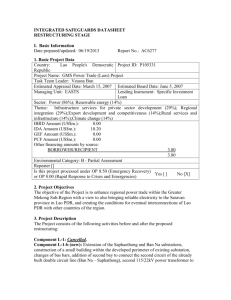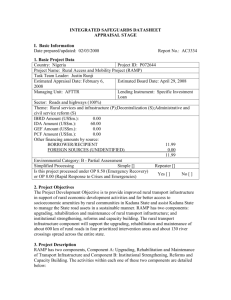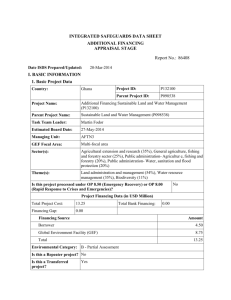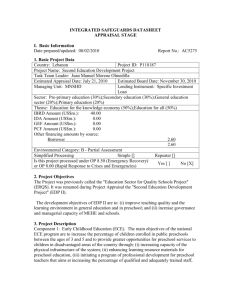integrated safeguards datasheet - Documents & Reports
advertisement
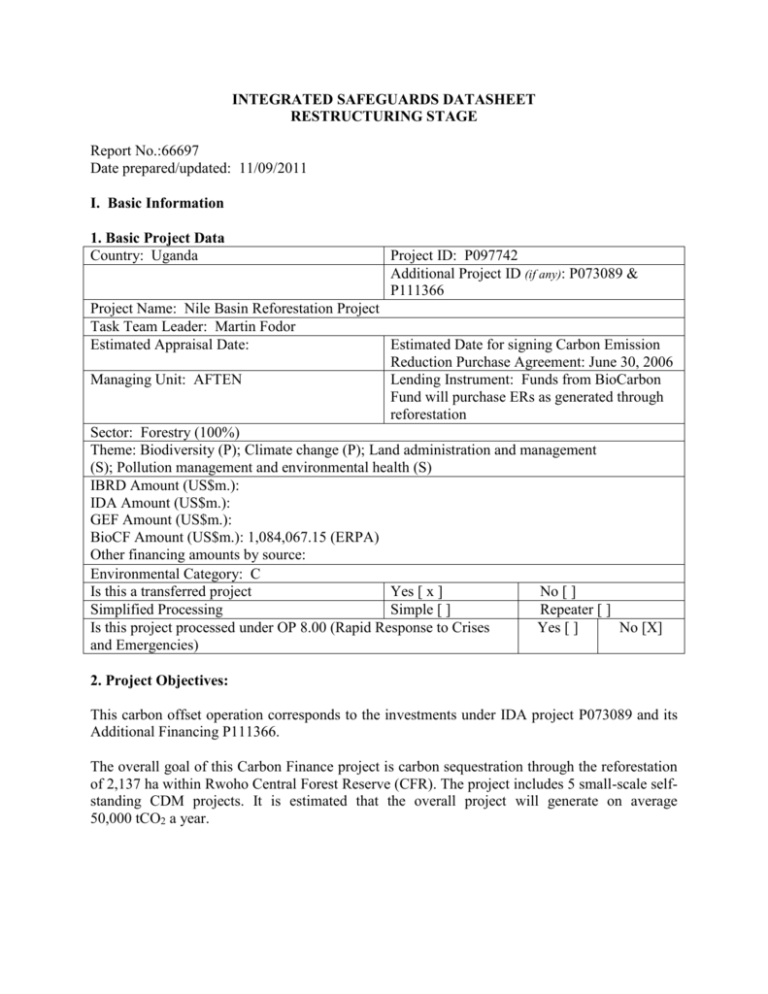
INTEGRATED SAFEGUARDS DATASHEET RESTRUCTURING STAGE Report No.:66697 Date prepared/updated: 11/09/2011 I. Basic Information 1. Basic Project Data Country: Uganda Project ID: P097742 Additional Project ID (if any): P073089 & P111366 Project Name: Nile Basin Reforestation Project Task Team Leader: Martin Fodor Estimated Appraisal Date: Estimated Date for signing Carbon Emission Reduction Purchase Agreement: June 30, 2006 Managing Unit: AFTEN Lending Instrument: Funds from BioCarbon Fund will purchase ERs as generated through reforestation Sector: Forestry (100%) Theme: Biodiversity (P); Climate change (P); Land administration and management (S); Pollution management and environmental health (S) IBRD Amount (US$m.): IDA Amount (US$m.): GEF Amount (US$m.): BioCF Amount (US$m.): 1,084,067.15 (ERPA) Other financing amounts by source: Environmental Category: C Is this a transferred project Yes [ x ] No [ ] Simplified Processing Simple [ ] Repeater [ ] Is this project processed under OP 8.00 (Rapid Response to Crises Yes [ ] No [X] and Emergencies) 2. Project Objectives: This carbon offset operation corresponds to the investments under IDA project P073089 and its Additional Financing P111366. The overall goal of this Carbon Finance project is carbon sequestration through the reforestation of 2,137 ha within Rwoho Central Forest Reserve (CFR). The project includes 5 small-scale selfstanding CDM projects. It is estimated that the overall project will generate on average 50,000 tCO2 a year. 3. Project Description: The project will provide access to carbon markets to the National Foresty Authority (NFA), as well as 6 community groups that participate in the benefit-sharing through Collaborative Forest Management. Emissions Reductions (ERs) are generated through reforestation. The carbon project is a component of an investment project P073089 and its Additional Financing P111366. There will be no additional investment for this carbon component. The NFA manages Rwoho CFR on behalf of the Government of Uganda as stipulated in the National Forestry and Tree Planting Act, 2003. NFA intends to re-forest 2,137 ha within the Rwoho CFR. The plantation is established in blocks of 25 ha on average, grouped in 5 smallscale CDM projects (Project 1 – 468 ha; Project 2 – 370 ha; Project 3 – 341.9 ha; Project 4 – 347.1 ha; Project 5 – 487.6 ha). The blocks are separated by the fire breaks. The project area will be covered with 75% Pinus caribaea planted on hill tops and slopes, which has already been introduced and tested in the area. In addition, valley bottoms and sheltered sites will be planted with Maesopsis eminii and Prunus Africana (20% and 5% respectively). Pinus and Maesopsis will be managed on a 22 year rotation cycle or until the target diameter of 45 cm is reached for timber production. Prunus will be managed on a similar rotation cycle for timber production, and, additionally, on a 10 year harvesting cycle for medicinal bark production. For all project-supported tree planting activities the NFA uses a preference scheme sourcing labor for clearing, planting, weeding, etc. mainly from the communities adjacent to the target forest reserves. A total area of 346.7 ha is planted by 6 community groups under the Collaborative Forest Management (CFM) agreements, including Project 1 – 65.6 ha; Project 2 – 35.9 ha; Project 3 – 22.7 ha; Project 4 – 22.2 ha; and Project 5 – 74.6 ha. Community groups that have CFM agreements for the project area are: BECA (Bushwere Environmental Conservation Association), KADA (Kanywamaizi Development Association), KAFODA (Kagoto Foundation for Development Association), RRECSO (Rwampala Rural Enterprises Cooperative Savings and Credit Society Limited), SWAGEN (Support for Women in Agriculture and Environment), and RECPA (Rwoho Environmental and Protection Associations). 4. Project Location and salient physical characteristics relevant to the safeguard analysis: The project area is within the Rwoho Central Forest Reserve in Mbarara, Isingiro, and Ntungamo Districts in south-western Uganda. The topography is mid altitude hill ranges from 1,400 metres to 1800 metres above sea level. The area is drained by numerous streams, some of which drain in Mishumba river in Rwoho, which itself drains into the Kagera river that is part of the Nile river system. The forested areas in the CFR are dominated by Albizzia-Markhamia tree species, which occur in valleys. Plantation establishment in Rwoho CFR with conifer species started in 1964. 5. Environmental and Social Safeguards Specialists on the Team: Ann Jeannette Glauber (AFTEN) Mary Bitekerezo (AFTCS) 6. Safeguard Policies Triggered (please explain why) Please note that the ISDS for this Carbon Finance activity does not trigger safeguards policies. Rather, the safeguards aspects are addressed through the parent project ( P073089) Environmental Assessment (OP/BP 4.01) Natural Habitats (OP/BP 4.04) Forests (OP/BP 4.36) Pest Management (OP 4.09) Physical Cultural Resources (OP/BP 4.11) Indigenous Peoples (OP/BP 4.10) Involuntary Resettlement (OP/BP 4.12) Safety of Dams (OP/BP 4.37) Projects on International Waterways (OP/BP 7.50) Projects in Disputed Areas (OP/BP 7.60) Yes No X X X X X X X X X II. Key Safeguard Policy Issues and Their Management A. Summary of Key Safeguard Issues 1. Describe any safeguard issues and impacts associated with the proposed project. Identify and describe any potential large scale, significant and/or irreversible impacts: The BioCF resources will help promote sustainable forest management in Uganda. Thus, the project is conceived and designed to have significant positive environmental and social impacts. The project will be supporting the rehabilitation of degraded forest areas in Uganda by replanting trees using the community co-management model. The aim is to improve the forest cover and environmental protection of the watersheds. The project will not result in any potential large scale, significant or irreversible impacts. The carbon offset operation corresponds to the investments under P073089 and P111369, and no additional investment will be needed. All necessary safeguards have been conducted under the parent project and disclosed under the same. 2. Describe any potential indirect and/or long term impacts due to anticipated future activities in the project area: No negative long-term impacts are anticipated due to project activities. 3. Describe any project alternatives (if relevant) considered to help avoid or minimize adverse impacts: N/a 4. Describe measures taken by the borrower to address safeguard policy issues. Provide an assessment of borrower capacity to plan and implement the measures described: Strong capacity exists for safeguard issues - the project is implemented by experienced technical staff in the national forestry agency that deal with the national environmental safeguards in their daily work, mainstream them as part of the core activities, and have received the Bank safeguards training. 5. Identify the key stakeholders and describe the mechanisms for consultation and disclosure on safeguard policies, with an emphasis on potentially affected people: The management of the reserve is the responsibility of the NFA. However, the National Forestry and Tree Planting Act, 2003 requires that the NFA manages the reserves in close collaboration and consultations with the different stakeholder categories. The key stakeholders are the communities surrounding project sites. They are consulted in the course of preparing Environmental Impact Assessment (EIA) and Forest Management Plan (FMP) in accordance with the requirements of the Government of Uganda and the World Bank, as prepared under the parent project. The EIA and FMP were duly disclosed in-country and through the InfoShop under the parent project (P073089). B. Disclosure Requirements Date Environmental Assessment/Audit/Management Plan/Other: Was the document disclosed prior to appraisal? Date of receipt by the Bank Date of "in-country" disclosure Date of submission to InfoShop For category A projects, date of distributing the Executive Summary of the EA to the Executive Directors Resettlement Action Plan/Framework/Policy Process: Was the document disclosed prior to appraisal? Date of receipt by the Bank Date of "in-country" disclosure Date of submission to InfoShop Indigenous Peoples Plan/Planning Framework: Was the document disclosed prior to appraisal? Date of receipt by the Bank Date of "in-country" disclosure Date of submission to InfoShop Pest Management Plan: Was the document disclosed prior to appraisal? Date of receipt by the Bank Date of "in-country" disclosure Date of submission to InfoShop n/a n/a n/a n/a n/a n/a n/a n/a n/a n/a n/a n/a n/a n/a n/a n/a n/a * If the project triggers the Pest Management and/or Physical Cultural Resources policies, the respective issues are to be addressed and disclosed as part of the Environmental Assessment/Audit/or EMP. If in-country disclosure of any of the above documents is not expected, please explain why: C. Compliance Monitoring Indicators at the Corporate Level (to be filled in when the ISDS is finalized by the project decision meeting) OP/BP 4.01 - Environment Assessment Does the project require a stand-alone EA (including EMP) report? If yes, then did the Regional Environment Unit or Sector Manager (SM) review and approve the EA report? Are the cost and the accountabilities for the EMP incorporated in the credit/loan? OP/BP 4.04 - Natural Habitats Would the project result in any significant conversion or degradation of critical natural habitats? If the project would result in significant conversion or degradation of other (non-critical) natural habitats, does the project include mitigation measures acceptable to the Bank? OP 4.09 - Pest Management Does the EA adequately address the pest management issues? Is a separate PMP required? If yes, has the PMP been reviewed and approved by a safeguards specialist or Sector Manager? Are PMP requirements included in project design? If yes, does the project team include a Pest Management Specialist? OP/BP 4.11 – Physical Cultural Resources Does the EA include adequate measures related to cultural property? Does the credit/loan incorporate mechanisms to mitigate the potential adverse impacts on physical cultural resources? OP/BP 4.10 - Indigenous Peoples Has a separate Indigenous Peoples Plan/Planning Framework (as appropriate) been prepared in consultation with affected Indigenous Peoples? If yes, then did the Regional unit responsible for safeguards or Sector Manager review the plan? Yes [ ] No [ x ] N/A [ ] Yes [ ] No [ x ] N/A [ ] Yes [ ] No [ x ] N/A [ ] Yes [ ] No [ x ] N/A [ ] Yes [ ] No [ ] N/A [ x ] Yes [ ] No [ ] N/A [ x ] If the whole project is designed to benefit IP, has the design been reviewed and approved by the Regional Social Development Unit? OP/BP 4.12 - Involuntary Resettlement Has a resettlement plan/abbreviated plan/policy framework/process framework (as appropriate) been prepared? If yes, then did the Regional unit responsible for safeguards or Sector Manager review and approve the plan/policy framework/process framework? OP/BP 4.36 – Forests Has the sector-wide analysis of policy and institutional issues and constraints been carried out? Does the project design include satisfactory measures to overcome these constraints? Does the project finance commercial harvesting, and if so, does it include provisions for certification system? OP/BP 4.37 - Safety of Dams Have dam safety plans been prepared? Have the TORs as well as composition for the independent Panel of Experts (POE) been reviewed and approved by the Bank? Has an Emergency Preparedness Plan (EPP) been prepared and arrangements been made for public awareness and training? OP/BP 7.50 - Projects on International Waterways Have the other riparians been notified of the project? If the project falls under one of the exceptions to the notification requirement, has this been cleared with the Legal Department, and the memo to the RVP prepared and sent? What are the reasons for the exception? Please explain: Has the RVP approved such an exception? OP/BP 7.60 - Projects in Disputed Areas Has the memo conveying all pertinent information on the international aspects of the project, including the procedures to be followed, and the recommendations for dealing with the issue, been prepared Does the PAD/MOP include the standard disclaimer referred to in the OP? The World Bank Policy on Disclosure of Information Have relevant safeguard policies documents been sent to the World Bank's Infoshop? Yes [ ] No [ ] N/A [ x ] Yes [ ] No [ ] N/A [ x ] Yes [ ] No [ ] N/A [ x ] Yes [ ] No [ ] N/A [ x ] Yes [ ] No [ ] N/A [ x ] Yes [ ] No [ ] N/A [ x ] Have relevant documents been disclosed in-country in a public place in a form and language that are understandable and accessible to project-affected groups and local NGOs? All Safeguard Policies Have satisfactory calendar, budget and clear institutional responsibilities been prepared for the implementation of measures related to safeguard policies? Have costs related to safeguard policy measures been included in the project cost? Does the Monitoring and Evaluation system of the project include the monitoring of safeguard impacts and measures related to safeguard policies? Have satisfactory implementation arrangements been agreed with the borrower and the same been adequately reflected in the project legal documents? Yes [ ] No [ ] N/A [ x ] D. Approvals Signed and submitted by: Task Team Leader: Environmental Specialist: Social Development Specialist Additional Environmental and/or Social Development Specialist(s): Name Date Martin Fodor (AFTEN) Ann Jeannette Glauber (AFTEN) Mary Bitekerezo (AFTCS) 09/11/2011 09/11/2011 09/11/2011 Alexandra Bezeredi (AFTOS) 11/11/2011 Idah Z. Pswarayi-Riddihough (AFTEN) 11/13/2011 Approved by: Regional Safeguards Coordinator: Comments: Sector Manager: Comments: (Template Version November 2007)
